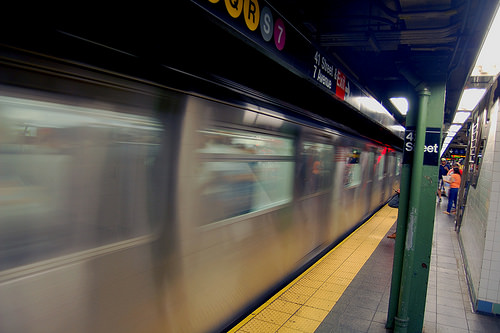How New York’s transit system may become car-funded
Could cars fund the New York City public transit system? A new Citizens Budget Commission (CBC) report proposes vehicle-based fees to fund the MTA for the next five years. The report, More than Fare: Options for Funding Future Capital Investments by the MTA, investigates the MTA’s existing financial obstacles and pinpoints methods of raising capital investment, asking two important questions: 1) How much money does the MTA really need? and 2) Where should it come from?

Image from PhotoHenning
The report was compiled by a transportation committee of the CBC, a nonprofit and nonpartisan watchdog group. It focuses on the best way to fund the MTA, and targets sourcing the new funds required for the agency’s 2015-2019 capital program. How much money does the agency require? The MTA says its $32 billion plan currently has a $15.2 billion gap. (It has $34 billion of debt, which account for about 17% of its yearly operating expenses.)
Yet upon investigation, the CBC report’s authors believe the gap in funding is larger. “We don’t think all of the recurring revenue they’re counting on is there,” Charles Brecher, the organization’s consulting codirector of research, told Capital. “So the gap, by our calculations, on the $32 billion is $19 billion.” As Capital explains, “Brecher’s explanation for the multi-billion-dollar gap between one multi-billion-dollar chasm and another is necessarily technical. It has to do with whether the M.T.A. can actually afford to contribute $290 million a year to its capital plan to support billions in new debt, or whether the M.T.A.’s cash reserves will be exhausted by 2018.”
The MTA’s funding woes aren’t merely New York-centric problems; in fact, they highlight two national challenges: the inefficiency of the gas tax to cover transportation costs, and the need for environmentally-friendly transit options that address climate change. While the federal government’s action is needed, the report points out, states also have responsibility: state governments supplement federal funds with taxes and fees, and they also make their own investment decisions.
New York is at a particularly pivotal point, note the authors: “New York State can be an especially important player in the development of an improved financing system because of the unique nature of its transportation system. More than any other state, New York—notably its economically important downstate region—relies on mass transit along with an extensive road network.” The MTA is the hub of this system.
The MTA has enough funds to meet its operating costs for the first three years of a four-year planning period, lasting 2015-2018. But there is a gap in funding for covering capital investment needs for the 2015-2019 capital plan, and the MTA hasn’t provided any solutions for how the state should make up the missing dollars. CBC looked into four funding options: “alternative tolling policies, higher motor vehicle registration fees, increased motor fuel taxes, and a new vehicle-miles traveled (VMT) tax.”
It proposes two potential solutions: the VMT tax, and a congestion pricing plan known as Move NY (the other two options investigated would not likely be able to raise sufficient cash). The tax would be implemented based on how far drivers travel, and, according to CBC estimates, would raise an estimated $2.1 billion yearly. “This option is attractive as a mechanism for mass transit funding and as a replacement for gasoline taxes for highway and bridge funding,” explains the report.
The Move NY plan would provide less — about $1.016 billion yearly, less than the $1.2 billion needed to underwrite the MTA’s debt — but has gained support among outer-borough and suburban advocates for its plan to lower outer-borough tolls. Plus, Move NY would have an added benefit of easing traffic, and there are benefits that will extend beyond the length of the capital plan: “[F]uture increases in its proposed toll rates have the potential to make even greater progress in closing the revenue gap in years after 2018. Combined with other options, this plan could be a key element in meeting the MTA’s future capital funding needs.”
Check out the report and learn more about the CBC’s take on the MTA’s financial challenges here.
Related Posts
Category: Transportation

















